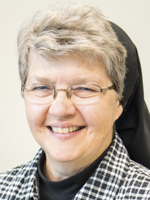
One day he and she are precious Pre-K tykes practicing for Christmas shows in which “the cute factor,” as early childhood teachers call it, overcomes all flubs and goofiness.
There will be at least one ham who steals the show, one who screams rather than sings, three who jiggle and tug at costumes and knock halos askew, and five who, despite admonitions, wave at parents and grandparents and mug for the videos they’re taking. Then, in a flash, they have drivers’ licenses and decide that anyone their senior, with the possible exception of a coach, is irrelevant. And then they’re turning 40.
During the Advent-Christmas seasons we’re inevitably reminded of the passage of time. Facebook floods us with memories and invites us to purchase a book of the photos we’ve posted over the last decade.
Cards featuring family groups arrive, and we notice that Jordi suddenly has a beard and Nana has let her brown-with-assistance hair go genuine gray. Time flummoxes us.
Certain human civilizations have believed that time is cyclical, a series of endless repetitions, and that people are born, die, and are reincarnated. Christians, however, believe that time is progressive. The whole of creation has a beginning from nothing — creatio ex nihilo, we call it. And creation has an ending, the Omega time spoken of in the Book of Revelation, the end of the world when Christ comes again. Thence “new heavens, new earth” ensue, and we dwell in eternity in the glorified bodies spoken of by St. Paul. Meanwhile, we are born, grow up, age, and die amid the world of time, which is itself a creation of God.
But we also experience certain aspects of our world in cycles. Twenty-four hour days, seasons, and years have their beginnings and endings, but also repetitions. The sun rises and sets and rises again. Fall chills into winter and winter warms into spring. The moon and the tides have their phases.
The Church also celebrates cycles of seasons, and we embark on a New Year every Advent. We move through a cycle of Christ’s birth-mission-passion-death-resurrection-ascension and the coming of the Holy Spirit that births the Church. We mark holy seasons over and over as we retell and remember salvation history. This prepares us for the time when time will be no more.
The funny thing about time and eternity is that we actually live in both. St. Thomas Aquinas describes us humans as amphibian. Just as frogs can live in air and water, we live simultaneously in time and eternity, on earth and in God’s kingdom, the one that is and is yet to be.
We can readily cite the empirical evidence of the passage of time. Each of us can record lines on a wall or door frame that track our rising height through childhood. We observe changes in our clothing and shoe sizes. And we go from tender skin to acne to, eventually, skin like crepe paper and sagging chins.
Time, as we experience it, is change and progression, flourishing and deterioration. Buildings and institutions rise, need repair, and sometimes collapse or are leveled for new construction. Each era sees new events, new families, new landscapes, new governments, new pastors and new papacies. The constants, the true reliabilities, the eternal verities, are, as St. Paul reminds us, faith, hope, and charity.
Amid a world of change, we insert the three purple and one pink candle in our Advent wreaths and repeat family traditions like the seven fishes or the oplatky/opłatek of Christmas Eve. We bake or receive the annual fruitcakes and cookies, and we hang the stocking which Great Grandmother crocheted. We seesaw between past and future as we go from Christmas customs to New Year’s resolutions. And we remain in the present as we pray, eat, and purchase and open presents.
That’s the thing about time. We are time travelers. In his “Confessions,” St. Augustine noted that our memories, our attention, and our imaginations make it possible for us to live in the presence of time past, the presence of time present, and the presence of time future. We remember, we are and act, and we anticipate.
This year, especially as we face holidays and holy days with the likelihood of less travel, less companionship, and the possible absence of loved ones because of distance or death, we can thank God for our humanity. Our minds and souls allow us to live a more-than life, in time and beyond it too.
The secret to doing that well is to live gratefully, with love. As we celebrate another round of New Years — liturgical and calendar — it is time to refresh our memories and renew our conviction that love lasts. God’s love lasts, above all, but all other genuine loves do too. Love extends backwards, forwards, and wraps around us. Forever.

